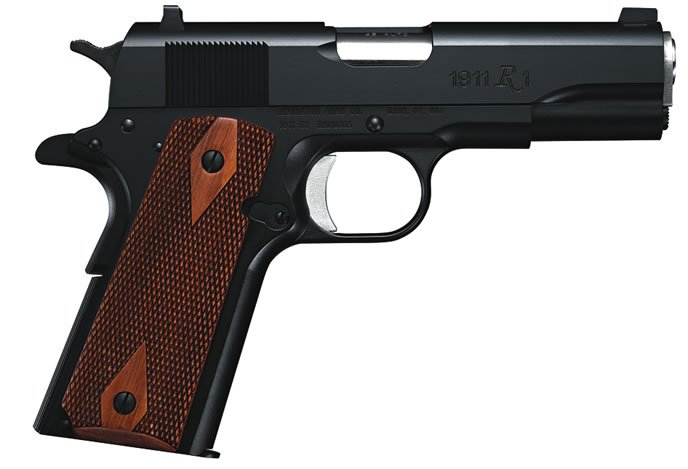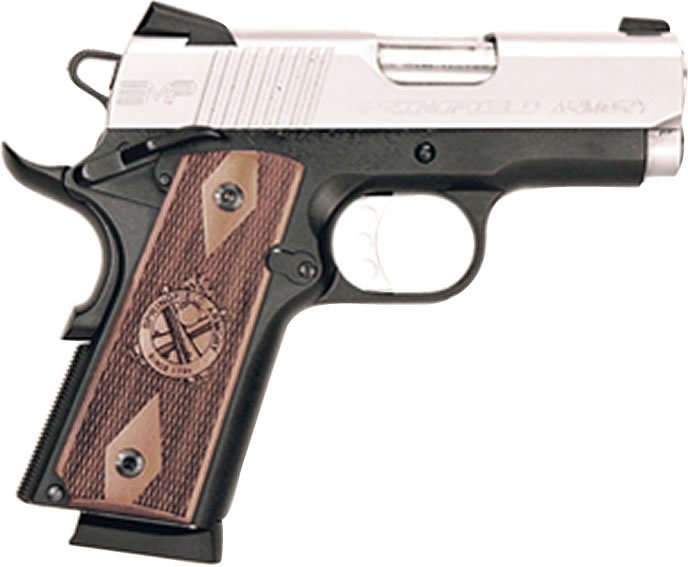Re: “Two Great Makers Shoot It Out: Remington Versus Colt 45 ACPs,” April 2015
Being a fan of Commander-Sized 1911s, I was pleased to see your review on the Remington R1 versus the Colt Commander. I’m wondering, however, why you didn’t choose the R1 Carry Commander for the comparison, as that would have been more of an apples-to-apples comparison. The R1 Carry Commander has a number of features that rival those of the Colt, among them: ambi-safety, bobbed and skeletonized hammer, three-hole trigger, slimmer grips, and better sights, including a Trijicon night sight front. It also has a melded treatment all over. Comparing the basic R1 with a Colt 1991 Commander might have been a closer comparison, as well.

I currently own a Ruger SR1911 LW Commander, a Colt LW Commander, a Remington R1 Carry Commander, an S&W 1911 SCE Commander, and a SIG Emperor Scorpion Commander. If you’re interested in an informal comparison of them, I wrote about it in my blog. Find it at TexasGunPros.net, under the Blog Posts title at the top of the page.
Scrolling through the blog, you’ll find some other articles about some of these guns. They all shoot well, and I shoot them all pretty well. The SIG is the one I shoot the best, but the easiest-carrying one (also the most expensive) is the S&W. I put some Rasco slim grips on it, and with the Scandium frame (it’s really aluminum with a drop or two of scandium in the mix, I’m told) it’s an easy all-day-carry gun.
I made note of this in my blog, but I honestly can’t feel an iota of difference between shooting a series 70 versus series 80 gun. And the only time I have a problem with a full-length guide rod is at cleaning time, and then it’s not really that much of a pain. I do appreciate your reviews, and I realize that it’s always going to be somewhat subjective because no two guns are alike.
— David Freeman
President/CEO
Texas Gun Pros, Inc.
TexasGunPros.com
Bob Campbell responds: “I simply purchased the first Remington Commander I was able to find. Though I like some of the features of the high-end guns, for the most part, the heart and soul is the same. If the pistol is mechanically reliable and the action is good, it is the fitness of the shooter that will mean the most. An R1 with its decent sights is a great gun. I am hoping to secure one of the Smith & Wesson Commander-size handguns soon.”
I read the Gun Tests evaluation of the Remington R1 Commander with great interest, especially the part about the malfunction. I just had a similar malfunction with my partially broken in (~100 rounds) full-sized R1. I was using standard Remington UMC 230-grain ammo and an 8-round Chip McCormick magazine. You didn’t say which magazine you were using. Do you think the magazine type could be a factor? Other than this one malfunction, I have been pleased with my R1.
—D. A.
Todd, I read the very interesting and enlightening test of the Remington and Colt 1911s. The Colt interests me very much, but I question the mainspring housing material. Many years ago, I purchased a stainless Colt Combat Commander and discovered that the mainspring housing was made of some sort of plastic. I sold that gun and never went back to looking at Colt 1911s. I’ve owned a number of Kimbers since, as they are all steel or aluminum alloy. If the gun you tested is all metal, I may take a look at a Colt.
— Frank
Hey Frank: All metal on the Colts we tested recently, either steel or aluminum alloy. We would mention other materials in the spec box.
— tw
Re “Special Report: Roessler Titan 6 Bolt-Action Rifle,” April 2015
I have just read your review of our Titan 6, and I commend you for your thoroughness. We are really pleased by the positive comments, and we are even more interested in the minor criticisms, which we will use in our consultations with Roessler to make the guns even better:
1) We’ve never had a firing-pin failure. I raised the firing-pin issue with Hannes Pr ckler, order and technical manager at Rler Waffen GmbH in Austria, and here is what he said about the firing-pin concern mentioned in the article: “We never had problems with it. The worst case was that the firing pin was lightly deformed after an blow-through with a proof cartridge.” So to address your point, we will henceforth provide free replacement firing pins during the entire five-year warranty period, and at cost thereafter.
2) Availability is not an issue — we have decent stock on hand right now — but we obviously need to step up our advertising. They are also available through Able Sporting Goods and soon, we expect, through our other dealer customers. In addition to the standard setups available 24/7 on our website, retail customers can order special setups by e-mailing us, with 24-hour price confirmation and 90-day delivery.
3) As your article was being written, we lowered our prices by about 9%, a response to the improved Dollar/Euro exchange rate.
Curiously, you invented a new spelling for the company’s name. In German it is “Rler.” In English it is “Roessler.” It’s obviously too late for the print addition, but would it be possible to correct the spelling on your website?
— Chuck Lutz
T R Imports Inc.
Fort Worth, Texas
Ray Ordorica responds: “Thank you for the update on your fine rifle. The general U.S. spelling of umlauted words is to insert vowels to get an approximation of the correct German sound, which I have never liked. As a long-term student of German I prefer the umlaut, but did not put an ess-zet in my report because the editor most likely would not have liked it.”
Mr. Lutz, thanks for getting with us. I’ve corrected the April online publications to “Roessler.”
— Todd Woodard
Re: “Firing Line,” April 2015; and “Mitchell’s Mauser,” March 2015
In the March article and related letters in the April Gun Tests, you omitted to state that the allegations of “force-matching” serial numbers, refinishing etc., have been made in reference to (so-called “Russian Capture”) German-made K98k rifles from WWII — not the postwar Yugoslav (Serbian) M48 rifles from the 1950s.

As for U.S.-made 8mm ammo being a “soft load,” there is a historical reason behind this fact. When the Germans first developed the 8mm cartridge circa 1888, the bore diameter was 0.318 inch, and early Mauser rifles were made to that specification for rather slow round-nose bullets. Prior to WWI, the diameter was changed to 0.323 inch, and the German military adopted a faster spitzer (pointed) bullet. Because earlier 0.318-inch-bore rifles had been brought into the U.S., American ammo companies made 8x57mm ammo with thick, soft copper jackets at a lower velocity, so the bullets could squeeze down to fit the 0.318-inch-bore rifles without causing excessive pressure. Foreign-made 8x57mm ammo designed for 0.323-inch-bore rifles is practically equal to the 30-06, per ballistic tables.
Though I’ve not made any purchases directly from Mitchell’s, I have examples of the various M48 models, the first being a “BO” imported circa 1986, and I have read the “For Collectors Only” book on Yugoslav rifles published by North Cape.
The Yugoslav M48 rifles, I believe, are all original Serbian Gov’t “surplus” and should make very nice shooters for people wanting a military-style 8x57mm rifle, regardless of importer.
—J. W. Mathews
When Ray Ordorica told a few local collectors that he had a Mitchell’s Mauser, they all wanted to see it. Lots of interest in them.
— tw
Re “Firing Line,” April 2015
Todd and staff, please keep up the good work, your publication is outstanding! I see a Firing Line letter from Alan Witter about slide-retraction effort, and saying “we’ll do it” creates a whole new set of hurdles on how to actually get it done consistently. I’ve attempted to measure this function myself on two different occasions, so I can appreciate what you’re going through. Finding a good digital gauge to measure the force of pull is a challenge right from the get-go. Trigger pull gauges typically don’t scale up high enough, so I ended up with a variable torque wrench “shade-tree mechanic” set-up, that seemed to be just OK. Then there was the gripping function itself; where on the slide did it need to clamp, considering the factory serrations or whatever to accommodate the grip tool, and how much torque, or pressure, needed to be applied there to keep it from slipping… “pinch force” is what I called it. I think some semi-autos need more “crack pressure” to get the slide moving than others, and that can create another different force figure. It is a lot like a trigger-pull measurement, where you have other factors to consider, like travel distance, creep, gritty feel, and the break itself, plus reset on a trigger.
Well, I’m thinking you’ll end up with terms for slides that you’ll have to standardize and explain, as well. There may be a significant difference between a cold gun and a warmed-up gun, too. My brief foray into this topic seemed to lead me down that path, too. I’m glad it’s being looked at, and by GT in particular, because I know you’ll get it right. Many people with less hand strength than others simply cannot operate some of the firearms out there, and it’s one more important piece of knowledge that you can spell out with your tests.
— Marc
Those are all good points, Marc. I appreciate your weighing in.
—tw
Handgun Fitting for Women
I am unsure if you have done an article in the past reviewing which semi-auto 9mms and 40 S&W pistols are most comfortable for women. I have smaller hands, and I don’t find many semi-autos are the right size for my grip.
Also, cleaning and slide release are difficult for me, too. Please let me know what your tests have concluded.
— Rebecca

I’ve wrestled with this for years, because it’s more of a size issue than a gender issue — that is, some men have small hands, too. Sad to say, I can’t answer this question for you personally without being able to see your hands. Off the top of my head, I’d suggest a Commander or Officer’s size 1911-style pistol in 9mm. Generally speaking, staggered-stack or double-stack magazines in higher-capacity pistols make them thicker in the grip, thus more difficult to handle for small hands. A single-stack nine, like Glock’s new G43, would be worth looking at as well. If you use the Comparison Tool on Gun-Tests.com, check the various grip measurements that accompany each gun. Guns like the Springfield Armory Enhanced Micro Pistol No. PI9240LP in 40 S&W (shown left) have the dimensions you’re most likely find comfortable: Front Strap Height, 2.1 inches; Back Strap Height, 2.7 inches; Maximum Width, 1.4 inches; Grip Thickness Max, 1.1 inches, Grip Circumference Max, 5.0 inches; and Trigger Span, 2.6 inches. Also, polymer handguns that have adjustable grip panels would allow you to tailor the grip circumference to your hand. Finally, find a store nearby that offers rental guns. There is no substitute for handling a pistol yourself.
— tw





























